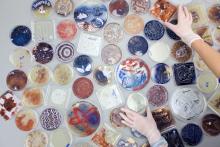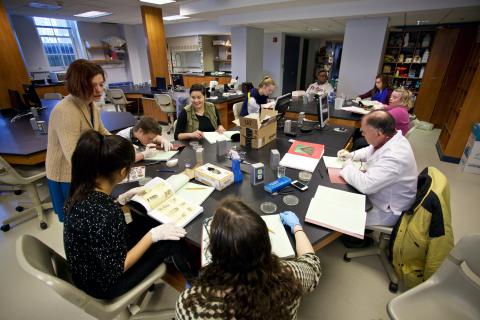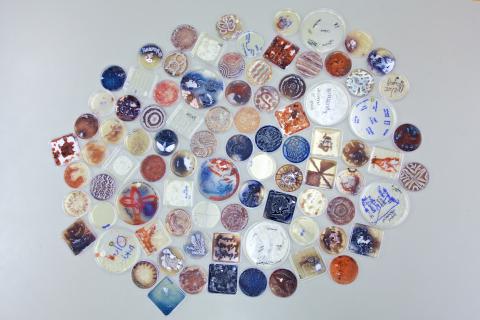 What is "BioArt"?
What is "BioArt"?
BioArt, or biological art, uses live tissues, organisms and life processes to both create and inspire artistic pieces.
Teaching & Learning with BioArt
"Critical Disability Studies is inherently an interdisciplinary field. The diverse disciplinary backgrounds that students bring to the course enable us to ask how a disability studies perspective reframes questions we are asking across the divisions. Disability studies opens up new ways of approaching everything from neuroscience to ethnography. In the course, we discuss the historical and theoretical development of the ideas of normalcy and disability; questions about ethical engagement and representation; the neurodiversity paradigm; and the growth of disability culture. Our partnership with CCW added an experiential and artistic component that became the heart of the course and generated discussions about creativity and accessibility, identity and community, storytelling and listening." - Kristin Lindgren, Haverford College
Public Course Archive:
Critical Disability Studies: Theory and Practice, 2017
Critical Disability Studies: Theory and Practice, 2016
"Culturing a Community"
 During a class conversation about disability arts and culture, we played with the word culture, using it as a noun (a culture), a verb (to culture), and a past participle (cultured). Culture resonates in the domains of both art and science. In the words of one student, they were “culturing a community" - with conversations between art and science, disability theory and engaged practice, Haverford/Bryn Mawr students and Center for Creative Works artists. This project embodies values of disability culture such as interdependence, creative collaboration, and multiple modes of communication.
During a class conversation about disability arts and culture, we played with the word culture, using it as a noun (a culture), a verb (to culture), and a past participle (cultured). Culture resonates in the domains of both art and science. In the words of one student, they were “culturing a community" - with conversations between art and science, disability theory and engaged practice, Haverford/Bryn Mawr students and Center for Creative Works artists. This project embodies values of disability culture such as interdependence, creative collaboration, and multiple modes of communication.
Art Emerges from a Science Lab
Over the course of three weeks, students and artists met in one of the teaching biology laboratory spaces at Haverford College to work with the colorful natural products produced by the harmless soil bacteria Streptomyces. Many scientists, including Haverford College chemistry professor Lou Charkoudian, study Streptomyces bacteria due to its antibiotic properties, but the bacteria also represents an awesome and untapped source of artistic biopigments. Each Streptomyces strain leaches a combination of pigments that determine its characteristic hue. Our first week, we spent time getting familiar with the laboratory at Haverford: we explored using microscopes to enlarge different objects, we discussed lab safety, and we sketched ideas for our bacterial BioArt. The following week was when the magic happened! Together, we used paintbrushes and Q-tips to streak a variety of colored Streptomyces strains onto petri dishes filled with a nutrient-rich semisolid medium. At first each strain appeared completely colorless in the petri dishes, but over the following week the cultured bacteria grew to produce a breathtaking array of colors, textures and patterns that we observed by eye and under a microscope during the last week in the lab. Both drawing from and disrupting conventional microbiological techniques, the BioArt project helped us discover new and beautiful ways to experience and communicate science through art.
“Symbiosis: Art, Science, & Community” Exhibition Catalog
View the exhibition catalog, including:
- essays about the partnership
- photos of the BioArt, the mixed-media art work
- photos of the students and artists working together in the laboratory and art studio
A "Symbiotic" Outreach Model, valuing the "Outsider Scientist"
Full-Text, open access article:
Vibrant symbiosis: Achieving reciprocal science outreach through biological art
Introduction:
 The persistent and growing inequity between the knowledge and resources of formally trained scientists and the general public makes it difficult for the public to relate to the work of scientists and even to distinguish pseudoscience from the real thing. This is especially true for groups traditionally excluded from science education and the scientific workforce, such as people with disabilities. Science outreach presents a promising means of bridging this widening gap by cultivating fertile ground for formally trained scientists and “outsider scientists” to interact. Drawing on the term “outsider artist,” which describes a working artist without formal training, here, we use “outsider scientist” to refer broadly to anyone engaging in science without formal training. The idea of an “outsider scientist” recognizes the scientific curiosity and potential within each of us, regardless of professional background, while also purposefully calling attention to the problematic, sometimes exclusive nature of science as a field.
The persistent and growing inequity between the knowledge and resources of formally trained scientists and the general public makes it difficult for the public to relate to the work of scientists and even to distinguish pseudoscience from the real thing. This is especially true for groups traditionally excluded from science education and the scientific workforce, such as people with disabilities. Science outreach presents a promising means of bridging this widening gap by cultivating fertile ground for formally trained scientists and “outsider scientists” to interact. Drawing on the term “outsider artist,” which describes a working artist without formal training, here, we use “outsider scientist” to refer broadly to anyone engaging in science without formal training. The idea of an “outsider scientist” recognizes the scientific curiosity and potential within each of us, regardless of professional background, while also purposefully calling attention to the problematic, sometimes exclusive nature of science as a field.
While traditional science outreach efforts have often focused on a one-way transfer of information from “experts” to “learners,” we recently experimented with an alternative outreach model that prioritizes building a reciprocal relationship between formally trained and outsider scientists. By explicitly valuing the backgrounds and goals of both groups, this model draws on active two-way communication as a more productive way to learn and retain information, while also creating an opportunity to enhance the mutual appreciation of traditionally disparate disciplines and people.
We experimented with this model of reciprocal outreach through “Symbiosis: Art, Science, & Community,” a collaboration between college students and adults with intellectual and developmental disabilities (IDD). The many expected and unexpected benefits of this collaboration inspired us to share our story with the larger scientific community to encourage others to find creative ways to engage with the public. Additionally, we aim to reduce the barrier to widespread adoption by providing specific and feasible guidelines for scientists to develop reciprocal partnerships of their own.
Citation: Lopes LE, Waldis SJ, Terrell SM, Lindgren KA, Charkoudian LK (2018) Vibrant symbiosis: Achieving reciprocal science outreach through biological art. PLoS Biol 16(11): e3000061. https://doi.org/10.1371/journal.pbio.3000061
Copyright: © 2018 Lopes et al. This is an open access article distributed under the terms of the Creative Commons Attribution License, which permits unrestricted use, distribution, and reproduction in any medium, provided the original author and source are credited.
Have questions about starting your own BioArt project?
We welcome your questions and collaborations! Please contact us to let us know what you're creating.
